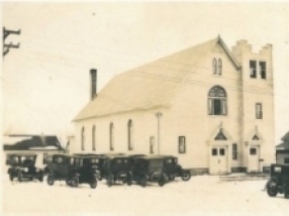
Our History...
St Paul Lutheran Church, founded in 1859, is a member congregation a larger Lutheran church body in America, known as the WELS (Wisconsin Evangelical Lutheran Synod). There are a number of WELS congregations in the area. A few of them like Bethlehem, Hortonville and Immanuel, Greenville spun off from this one over 150 years ago. But how long we’ve been around is not what makes us different or any more special than other churches in the area. It’s our approach to God’s Word. Week in and week out the people at St. Paul are treated to a message from God’s unchanging Word. Each week the Holy Spirit prepares something new to feed and nourish our soul. Through our partnership with our national church body, the WELS we can help spread God's kingdom throughout the world. (Learn more about our teachings here)
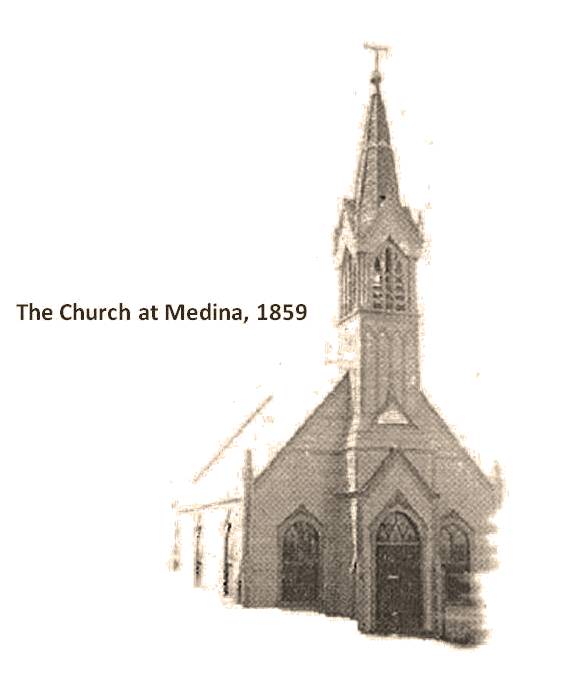 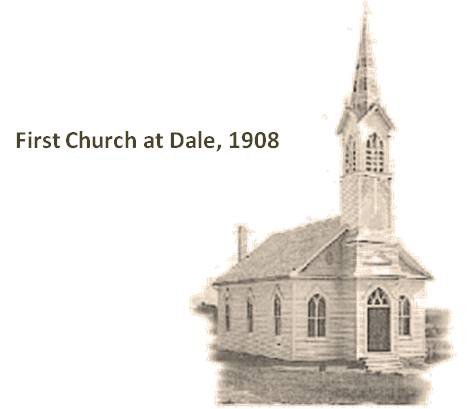
History of St. Paul Ev. Lutheran Church
Dale, Wisconsin. 1859 - 2016
The First Fifty Years: 1859-1908
St. Paul Evangelical Lutheran Church was founded in large part because of events and conditions in Germany in the early 1800’s. Fredrick William, King of Prussia, had forcibly combined the Lutheran and Reformed Churches as one Church. When the Lutherans in that country were no longer permitted to worship the true God as they had been taught and as their conscience dictated, many sold everything they had, left Germany, and immigrated to the United States. By the time Wisconsin became a state in 1848, many thousands of German Lutherans had made Wisconsin their home.
Those who came to the Dale-Medina area found the land covered with heavy timber and large swamps. Not one acre was cleared. The first task was to build a log home for their families. Timber had to be cut and stumps and roots had to be removed by hand, because there was no heavy machinery to do the job. Once the log homes were built, land had to be cleared to plant grain so there would be food to eat. Few had any money left after paying for their trip to America. In order to earn some money, some of the men processed pine pitch and in the spring made maple syrup and sugar, which they sold in the neighboring towns. Almost every penny earned was used to pay the debts on their land.
The log cabins were cold, damp, dark and often had only dirt floors. They were difficult to keep clean. Even if the German immigrants had had some money, any stores that existed were very far away, and there were no roads. To feed their families, the women ground their own flour and prepared whatever wild game the men brought in. The women made all the clothes their families wore and even the furniture. Sometimes an entire home was furnished with the wood from barrels.
Though they did not have much in earthly goods, the early settlers had the one thing that they cherished most: religious freedom. They also had their Bibles, their hymnals and their catechisms, which they had brought along from Germany. They walked long distances to gather for 2-3 hour Sunday worship services. Going to church took up the whole day when you consider the long walk through woods and mud swamps. Families ate lunch after their worship services and visited with one another. It was the only social outlet that they had.
One need that was keenly felt was the lack of a pastor or shepherd who could preach the Word, administer the Sacraments, and instruct the children. In 1846 German mission societies began to send missionaries into Wisconsin. The First German Evangelical Lutheran Synod of Wisconsin was organized on May 27, 1850 in Granville, Wisconsin. In the next few years the number of pastors and congregations that joined the Synod grew rapidly. According to the records available, St. Paul has been a member of the Wisconsin Evangelical Lutheran Synod from its earliest beginnings. It has always been served by WELS pastors.
Pastor Gottlieb Fachtmann was the first pastor to visit the German immigrants in the Dale-Medina area. Pastor Fachtmann served a congregation in Washington County, but in October, 1857 he traveled on foot to Sheboygan, Fond du Lac, and Menasha. Following the Wolf and Rat Rivers he stopped at Medina for a few days, preaching and offering the sacraments. Pastor Fachtmann’s next visit to the Medina area was almost a year later, in August, 1858. One hundred and twenty attended services and eleven were baptized.
In July, 1859 Pastor Fachtmann resigned his pastorate at Fond du Lac, and left for LaCrosse, Wisconsin. Before he left, however, he transferred the entire northern part of his field of labor to Pastor Carl F. Waldt, who had just come to Wisconsin from Alsace, Germany, where he had been a traveling missionary for five years. He became pastor in Menasha. Using that as his headquarters, he served this district, traveling by foot and holding services here about once every four to six weeks. It was just at this time, in the summer of 1859, that our St. Paul Congregation was organized, whether by Pastor Fachtmann or by Pastor Waldt, we cannot be sure. But it may well have been Pastor Carl Waldt, since he served the members of this area as assistant to Pastor Fachtmann already in May.
Only eleven voting members were present to sign the constitution and the organization papers on that joyous day in 1859, but this was a good percentage of the people living in this area at that time. Although Pastor Waldt often had difficulty getting here because of weather conditions, deep snow, high water on the Rat River and other hardships, services were held regularly and were well attended. Generally between fifty and sixty people were present. It was a period of change, of shifting and organizing, so that from 1859 to 1865 the size of the congregation was never settled. With each year more people were moving into the area and the size of the congregation increased. Then, as groups from Hortonville and Greenville, for example, became larger, they left to establish separate congregations closer to their homes. As a result, our church would decrease in membership.
During the first twenty-nine years, from 1859 to 1888, St. Paul used the same buildings for its worship as the Reformed congregation in Medina, first in a schoolhouse and then in a church building they erected together. In 1888 the Reformed congregation moved to the Village of Dale. St. Paul then built a new church on the old location, directly across the road from the Dale Union Cemetery, one and a half miles east of Dale, in the township of Dale. New articles of incorporation were drafted and signed on September 25, 1888. The Dale Union Cemetery was formed jointly by St. Paul and the Reformed Church. The original ruling was that lots should be sold alternately to Reformed and Lutherans. In later years this rule was no longer enforced.
 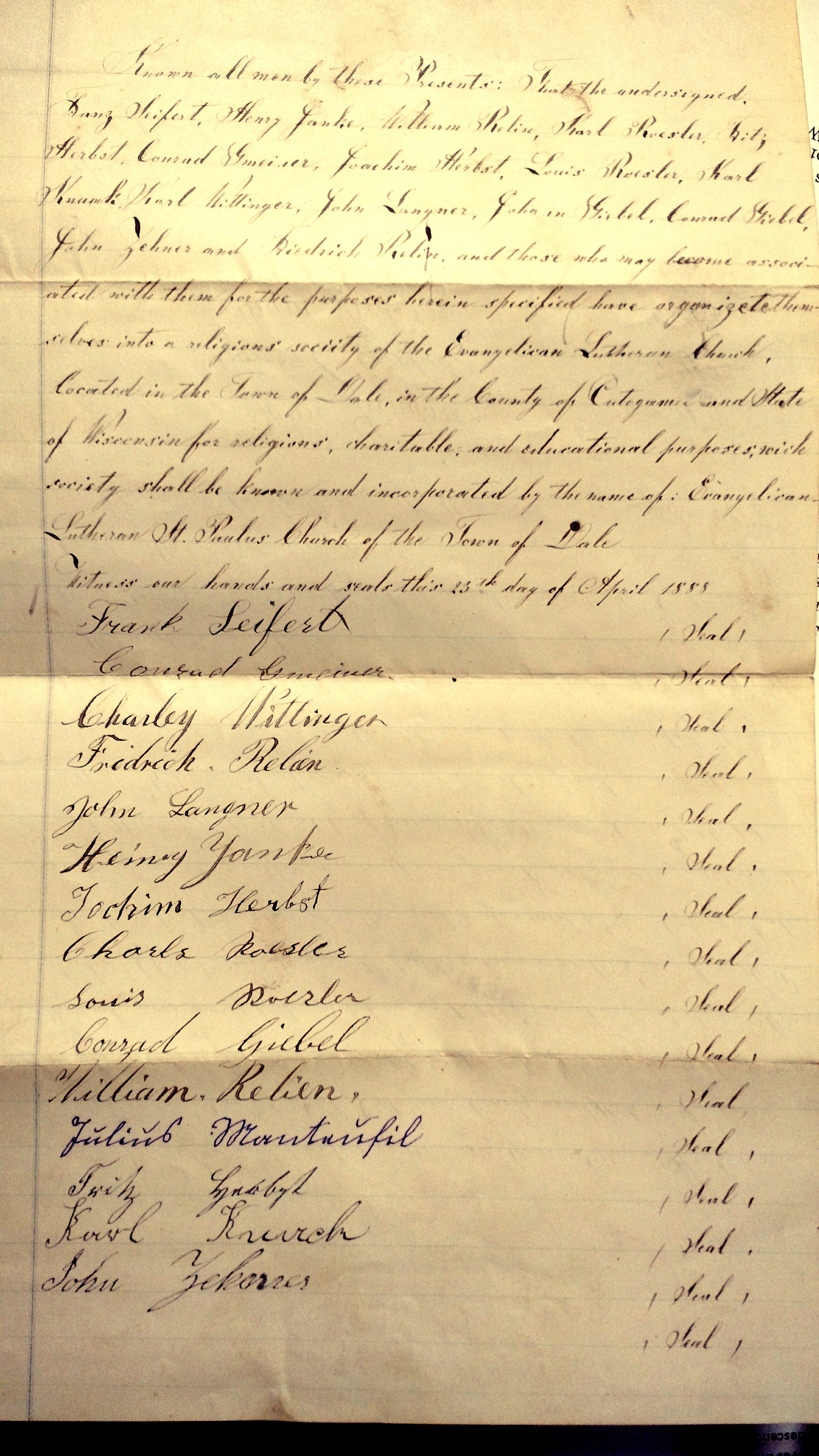
After the railroad was built through Dale in 1871, that area began to grow faster than the area around Medina. When a windstorm struck the church on May 11, 1908, tore down the steeple, and moved the church from its foundation, it was decided to rebuild in Dale where there was more opportunity for growth. The minutes of a meeting held in May state as follows: “It was moved and seconded that since the rebuilding of the church at Medina would cost $1,340, while the moving and building at Dale altogether would be only $2,049.24, and since there is more opportunity for growth in Dale than in Medina, that therefore we relocate our church and rebuild in Dale.” The motion carried by a very small majority. St. Paul was then moved, a new church built, and the dedication services were held on September 27, 1908. The celebration also included the 50th anniversary of the congregation. The first English sermon was preached in the afternoon service.
Besides Pastor Fachtmann (1857-1859) and Pastor Waldt (1859-1864 and 1868-1870), the following also served St. Paul during its first fifty years: Pastor Theo. Jaekel (1864-1868), Pastor Otto Spehr (1870-1871), Pastor H. J. Haack (1871-1873), Pastor Traugott Gensike (1874-1880), Pastor Albert Kluge (1880-1895), and Pastor G. E. Boettcher (1895-1913). Only Pastors Haack and Boettcher were born and educated in this country. The others came as missionaries from Germany. The pastorates of those who served during the first fifty years were generally very short. The eight pastors who served during this period were all shared with other congregations. St. Paul would not have its very own pastor until 1913.
The Second Fifty Years: 1909-1959
During the second fifty years of St. Paul’s history God in his grace and mercy blessed our congregation with increased activity and growth. In 1910 Christmas bags were given to the children to remind them of God’s great gift to us, the gift of his only begotten Son. In 1911 the first school was built for our children. It measured 18 by 26 feet and was located on the east side of the church. It remained in use until 1970. The first formal School Board was elected in 1912 and a summer school term of six weeks was approved. A seminary student, Mr. L. Baganz was called to teach.
On May 1, 1913 the voters decided unanimously to call a pastor who would serve St. Paul exclusively. Although Pastor Boettcher had served the congregation faithfully, he could devote only part of his time to St. Paul. The congregation had also grown greatly since the new church was built in 1908. The congregation now had 59 voting members. The congregation called candidate L. Baganz, who had already been called to teach the summer school session. Mr. Baganz accepted the call and on July 20, at the end of the summer school session, was installed as St. Paul’s first pastor. Besides his ministerial duties, Pastor Baganz was expected to teach school six months a year about four days a week. He was given an annual salary of $500 besides free housing. The congregation purchased a home on Main Street in Dale to serve as a parsonage.
In 1913 the first English services were instituted. The Senior Choir and the Young People’s Society were both organized in 1914 and the free will offering system was started. In July, 1915 gas lamps were installed in the church so that better light might be available for evening services. By January, 1918 the summer school had grown to 17 students plus six confirmands. Although all the work was still being done in the German language, the English language was beginning to makes its influence felt more and more, especially among the younger people of the congregation. The first English Communion Service was conducted in June, 1920. A Sunday school in English was organized in January, 1923, and by the summer of 1924 even the summer school was taught in English as well as in the German language. On December 1, 1924 twenty ladies of St. Paul met and organized the Ladies Aid.
By 1925 the congregation had become too large for the church building, and plans for correcting the situation were being made. By early 1926 it was decided that both the inadequate size of the building and the need for its repair, including the installation of an electrical system and new heating system, made it more practical to tear down the old church and build a new and larger house of worship. According to the minutes of the meeting, the total cost of the building, with labor donated, was not to exceed $13,500. The size was to be 36’ by 70’ by 18’ with a 16’ choir loft. On September 5, 1926 the cornerstone of our present building was laid and a joyful congregation dedicated the new church to the Lord’s service on January 9, 1927. Many people came from neighboring congregations to join in the joyous celebration. Those present at the services would never forget the severe snowstorm that day. It was with great difficulty that many returned home. But even the severe weather could not dampen the joy of this occasion.
1934 was an important year. St. Paul Congregation celebrated its 75th Anniversary on June 24. One of the morning speakers was Pastor Boettcher of Hortonville. The congregation now numbered 90 voting members, 280 communicants and 378 souls. In 1934 the congregation began to follow the form of service as it was found in the hymnal so that its form of worship would be the same as that of other congregations of the Synod. Visitors from other WELS churches would feel more at home attending our church services. Also in 1934 a fund for a pipe organ was begun (Click here for a complete history of our pipe organ). Because of the growth of the congregation, a three-man council was considered too small to fully carry out the necessary work in the church. On January 10, 1937 the council was expanded to a chairman, three trustees and three elders. Quarterly meetings were instituted to carry out the business of the congregation. In 1941 the congregation began to use a new hymnal produced by the Synod, although the liturgies of the new hymnal were not accepted until 1942. A pipe organ was purchased and installed in 1941. By 1946 the attendance at German services had grown so small that regular German services were eliminated, leaving one evening German service a month.
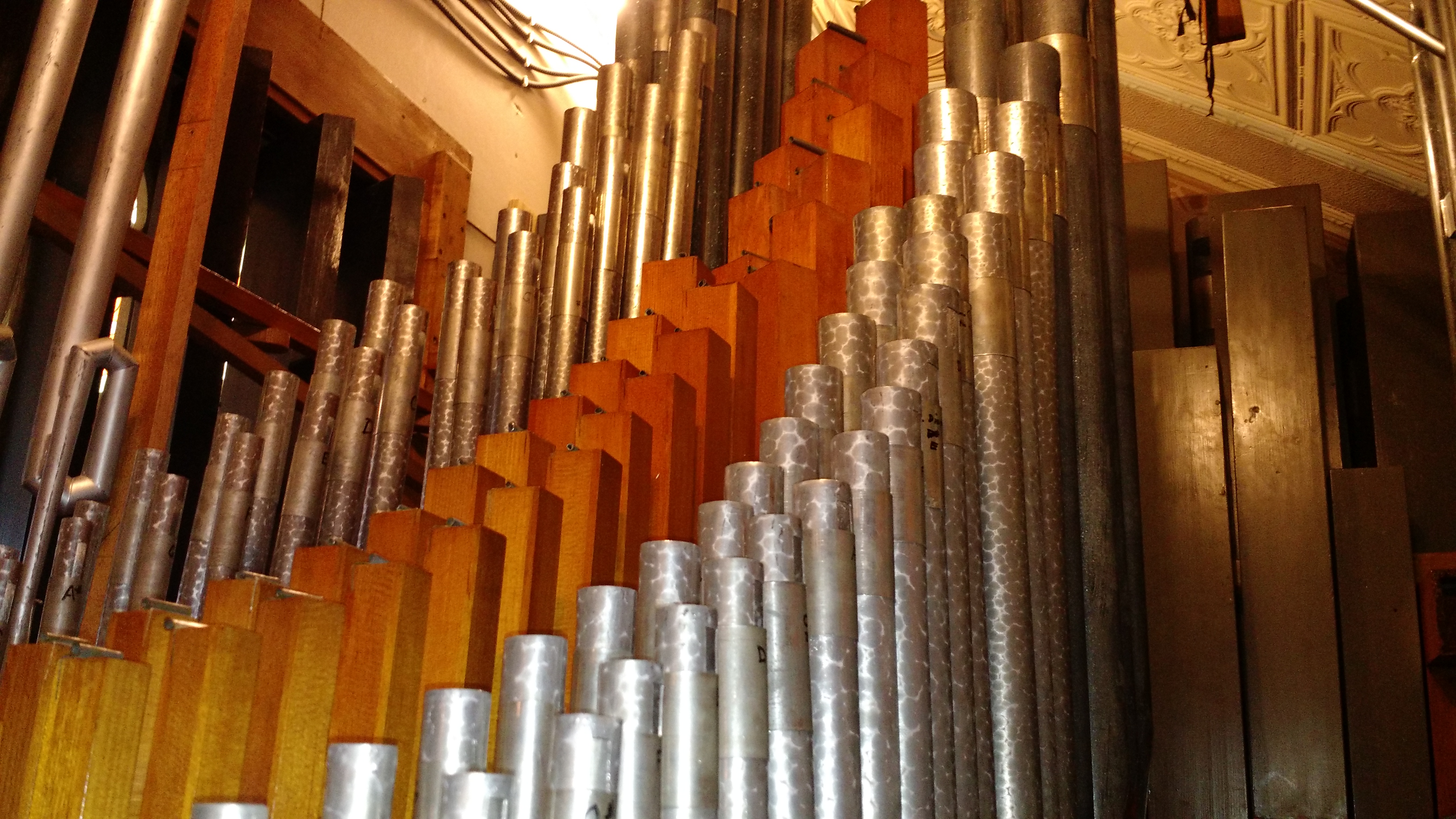
St. Paul was one of the first area congregations to elect a delegate to the association planning to start a new Lutheran high school. Planning for the high school started in 1946. Recognizing that Christian education was important, but not willing to establish a Christian elementary school, the Congregation organized a Saturday school in 1947. Summer school sessions were shortened from six to three weeks. A new parsonage was dedicated in 1951 after the second lot south of the church was purchased. A Mens Club was organized in 1953. New restrooms were installed in the church in 1954. The lot next to the parsonage was purchased for $300 in 1955. Organ chimes were installed in 1957. Fox Valley Lutheran High School formally opened in 1957 with 278 students, 9 full time and 2 part time teachers. St. Paul became a member of the FVL Federation in 1958 and remains a member to this day.
1959 was a busy year. The entrance of the church was remodeled, providing wider steps into the nave and basement. The interior of the church was redecorated. The chancel and aisles were carpeted. The redecoration was completed at a cost of $13,500 and dedicated to the Lord’s service on May 31, 1959. In June St. Paul celebrated its 100th Anniversary with daily services from the 14th through the 21st. Among the guest pastors invited were former pastors and the sons of former pastors. One of the guest pastors was Pastor Marlyn Schroeder, the first pastor to be ordained from St. Paul. For seven days the people of St. Paul rejoiced in the spiritual blessings God had richly and freely showered upon them for one hundred years. They rejoiced that the Lord had preserved in their church the precious gospel of their Lord and Savior in all its truth and purity and the blessed sacraments as Christ had instituted them. As they rejoiced, they confessed with the saints of old, that they were not worthy of the least of God’s mercies.
The eight pastors whom the Lord sent to serve the congregation during its second fifty years were the following: Pastor G. E. Boettcher (1895-1913), Pastor Louis W. Baganz (1913-1917), Pastor Frank A. Reier (1918-1931), Pastor Waldemar F. Zink (1931-1943), Pastor Norbert Reim (1944-1954), Pastor Gerhard W. Franzmann (1946-1949), Pastor Harold E. Warnke (1949-1954), Pastor Erwin H. Ploetz (1954-1971). All eight pastors in this period were born in the United States and educated in our WELS seminaries in Wauwatosa and Mequon, Wisconsin. Pastor Reim left St. Paul to serve as a missionary in Nigeria, West Africa. Pastor Warnke left to become the Principal of Fox Valley
Lutheran High School. Pastor Ploetz was actually born and baptized just a few miles away at Zion Ev. Lutheran Church in Readfield. He would serve St. Paul until the Lord called him to heaven in 1971.
The Most Recent Fifty Years: 1959-2009
In 1960 a Couples Club was formed. In May of 1961 the congregation voted to have two regular Sunday services. A Junior Choir was started in 1962. Lutheran Pioneers and Lutheran Girl Pioneers were established in the fall of 1964. In 1966 a forced air coal furnace with a new boiler system was installed. In 1968 the Church Constitution was revised and the church parking lot was blacktopped.
The church basement and the small school were now filled to overflowing with 150 Saturday school students and 167 Vacation Bible school students. After investigating various options, the congregation voted to begin construction of a 44’ by 60’ school attached to the rear of the church. The capacity of the new school would be approximately 235 students. New restrooms were included. The total cost for the project was $64,000. In September of 1971 the new school was dedicated to the Lord’s service.
 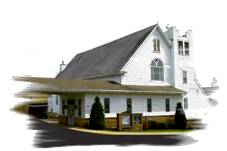 When God called Pastor Erwin Ploetz to himself in heaven on September 19, 1971, St. Paul Congregation had grown to 731 baptized souls and 519 communicants. This was the high water mark for membership in the 150-year history of St. Paul. At the end of 1972 the Statistical Report of the Wisconsin Synod reported 683 souls and 492 communicants at St. Paul.
When God called Pastor Erwin Ploetz to himself in heaven on September 19, 1971, St. Paul Congregation had grown to 731 baptized souls and 519 communicants. This was the high water mark for membership in the 150-year history of St. Paul. At the end of 1972 the Statistical Report of the Wisconsin Synod reported 683 souls and 492 communicants at St. Paul.
The LWMS was formed in 1972. A speaker system was installed in the church in 1974. In October of 1976 a mortgage burning ceremony for the new school was held. In five short years the $64,000 had been paid in full. The congregation was very grateful for this great blessing from the Lord. In the early 1970’s risers were built for the nave area to seat the children for the Christmas Eve service. In 1979, after thirty years of teaching Saturday school and Vacation Bible school, Winnifred Laabs retired.
Anticipating the congregation’s 125th Anniversary, plans were made to remodel the front entrance of the church, redecorate the interior of the church, and to establish a scholarship fund for seminary students or teachers. This was the congregation’s expression of thanksgiving for 125 years of blessings from the Lord. When the remodeling was finished, the building was re-dedicated to the Lord’s service on November 13, 1983. The total cost of the project was $128,787. Also in 1983, a vacant lot across from the church was donated to the church and developed for parking. St. Paul’s 125th Anniversary was celebrated in June of 1984. A former pastor, Waldemar Zink, preached on June 3. On the actual Anniversary Sunday, June 10, Pastor Richard Warnke preached in the morning. His father Harold had served the congregation from September 1949 to October 1954. In the afternoon the pulpit was occupied by Pastor Elroy Conradt, another son of the congregation. The newsletters and all the correspondence at that time stressed that this anniversary was a time of thankfulness to the Lord for his manifold blessings. A pictorial directory was published.
In 1987 new altar cloths were purchased. That same year the voters decided to pay 90% of the tuition for Christians elementary school students sent to WELS schools in our area. In 1988 the voters decided to send the Northwestern Lutheran (now called Forward in Christ) to every family. From 1990 to 1994 a Monday night service was conducted during the summer months. A computer was purchased for the church office, a new playground was constructed for the children, and a new 2-car garage was built for the pastor and his family. St. Paul Congregation joined the Adopt-A-Highway Program in 1993 and continues serving the community in that capacity to this day. Refuse is picked up on the 2 and ½ miles west of Dale on State Highway 96. In 1993 a Evangelism/Stewardship Board was established. That led to a Greeter Program to greet visitors, regular Visitor Sundays, and regular religious canvasses of our neighborhood. Also in 1993, the congregation began to use an new WELS hymnal called Christian Worship.
In 1994 the 135th Anniversary of the congregation was celebrated. That same year we provided hearing devices for those who had trouble hearing during the worship services. The parsonage bathroom was remodeled. In 1996 both parking lots were blacktopped (Repeated in 2013). In 1998 our Saturday school was changed to a Sunday school. Recognizing the need to reach out to the community in a meaningful way and looking for an opportunity to spread the good news about Jesus to others, the congregation began in 1996 to study the feasibility of having a child care center. After two years of study, the congregation dropped the idea, because sufficient support did not seem to exist. Then an anonymous gift of $50,000 was given for this purpose, and the congregation renewed its study. Finally, on April 25, 1999 the voters decided to begin a Christian childcare center. It would be self-supporting, and its purpose would be to teach children in our care about Jesus. After extensive remodeling of the school, Come Unto Me Childcare opened on October 25, 1999. After one year there were 55 full and part time children cared for by 2 full time and 8 part time teachers. The childcare continues to be a major effort by our congregation to reach out with the gospel to others, especially to Jesus’ little lambs. It is greatly appreciated by those it serves. In the year 2000 air conditioning was installed in the school. The brick facing on the north and west sides of the church was replaced. In 2001 a pitched roof was put over the flat roof of the school, and insulation was added, at a cost of $16,000. At the end of 2001 Mrs. Delores Scott retired because of ill health. She had served for 28 years as our Senior Choir Director. In 2002 a small addition was made to the south side of the church to serve as a laundry and storage for the childcare. A new oil furnace was installed in the parsonage. The voters adopted a mission statement. In 2003 a television set was mounted on the front wall of the church to enable the congregation to view the WELS Connection. Also, the windows were replaced in the school. In 2004 the door for the handicap entrance was reworked so that caskets could be wheeled up the handicap ramp of the church.
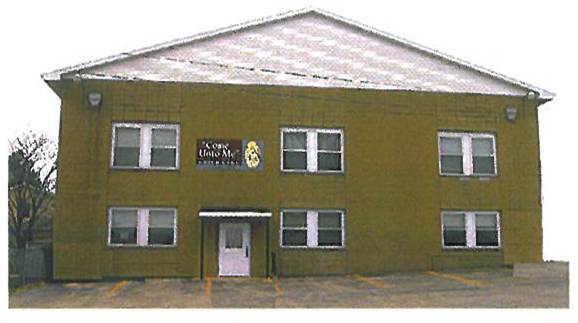
On August 25, 2013, a special meeting of the congregation was convened to consider the state of the child care ministry. Due to changing demographics and declining numbers, it became more and more difficult to maintain our child care ministry. By unanimous vote our child care was closed after nearly thirteen years of operation. To alleviate a debt of $15,000 in operational expenses the church secured a loan and conducted an auction of all the child care furnishings and equipment. It was a difficult page to turn in our congregation's history, but as God closes one door, he many times opens another. Soon after the congregation remodeled what was formerly an infant room in the child care into a new adult & teen Bible study room. At preasent, 15-20 teens regularly attend a weekly Bible study, many of whom are unchurched.
.jpg)
On Saints Triumphant Sunday, November 15, 2015, the church's pipe organ was rededicated to service after many months of repairs and tuning (Click here for a complete history of our pipe organ). In June, 2016, as a gift to Pastor Finn for his service to the congregation, the parcel of land next to his house was deeded over to him. This parcel was originally for $300 and was formerly the site of a catholic church that closed early on before St Paul made the move to Dale.
The four pastors whom the Lord sent to serve the congregation during it’s third fifty years were the following: Pastor Erwin H. Ploetz (1954-1971), Pastor David Voss (1972-1976), Pastor Kenneth Seim (1976-1989), Pastor Lyle L. Luchterhand (1989-2008) and Pastor William A. Finn (2009-2019). “How beautiful on the mountains are the feet of those who bring good news, who proclaim peace, who bring good tidings, who proclaim salvation, who say to Zion, ‘Your God reigns.’” (Isaiah 52:7)
Presently, there are 267 communicants and 224 baptized souls at St. Paul. Considering the many precious souls won for eternal life through God's work among and through the people of St. Paul, we truly can say along with the apostle that our labor in the Lord is not in vain." We truly are blessed by the divine love, forgiveness and watchful care of the Lord these 150 years--and counting! May the Lord preserve us and sustain us through the purity of his Word that we may continue to stand on his sure promises that center in our Savior Jesus Christ!
May we ever be grateful!
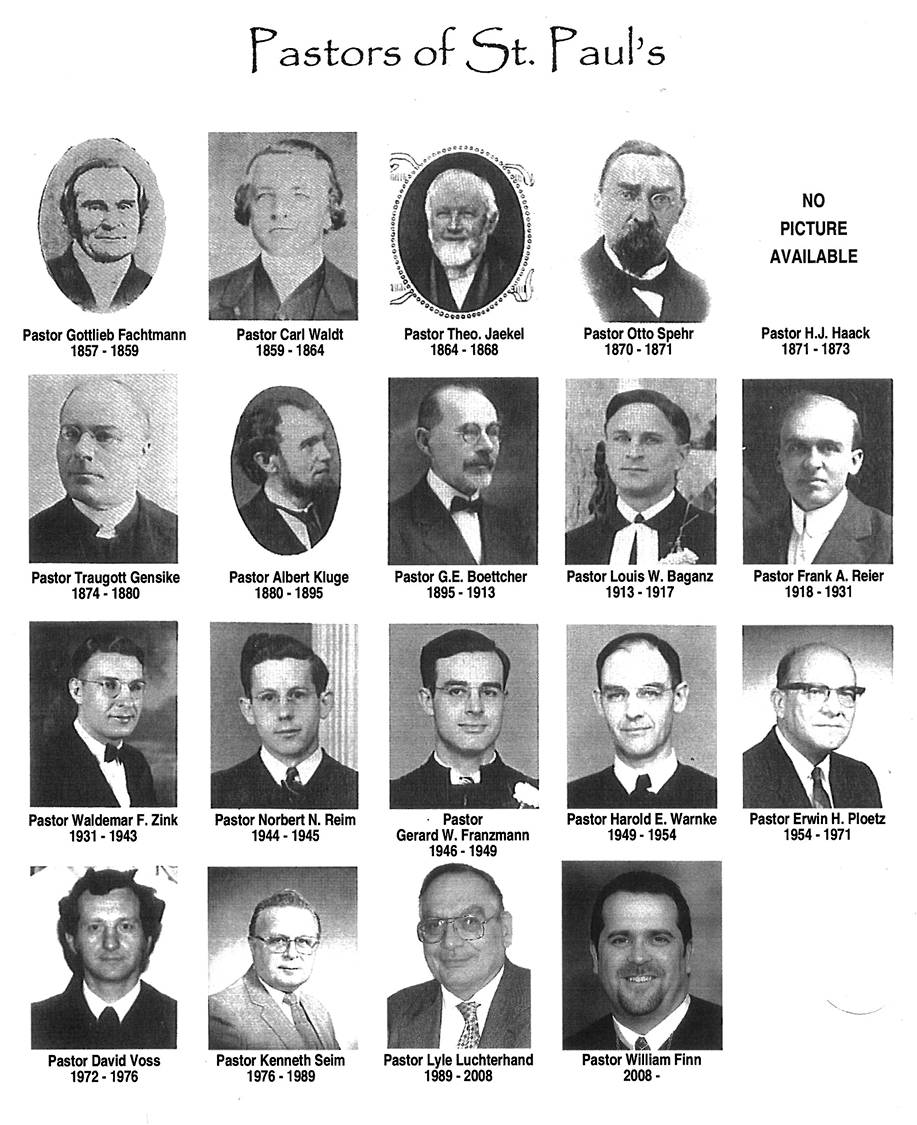
|
|
|